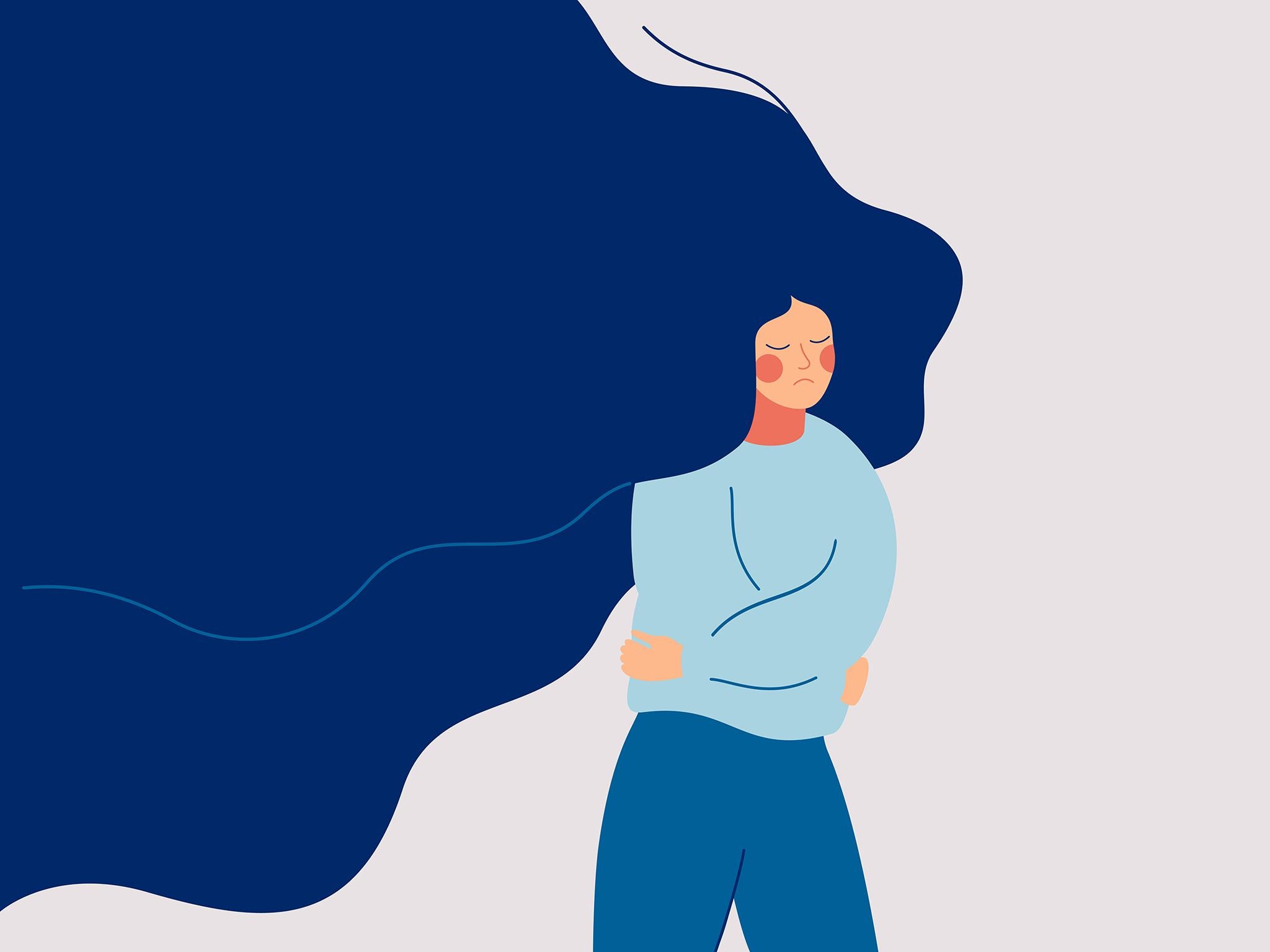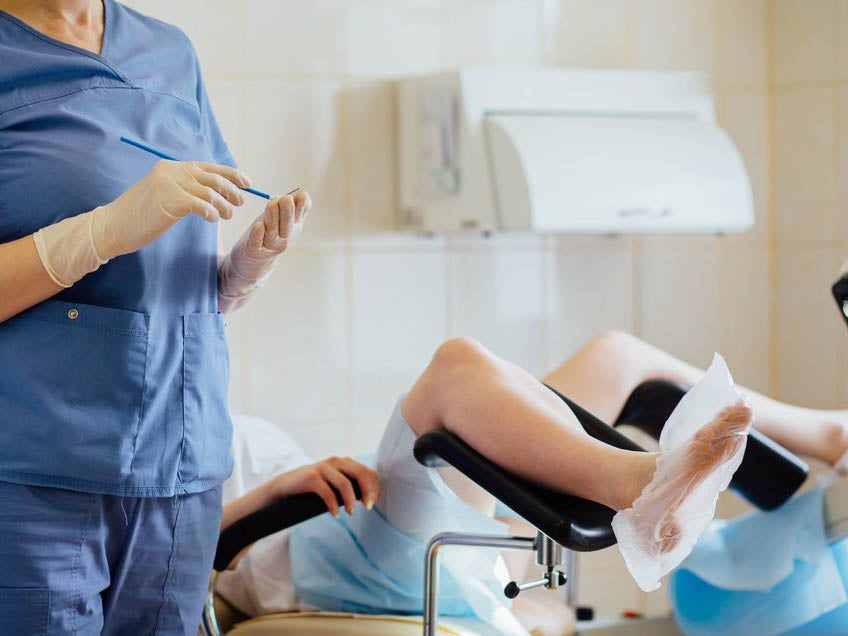The gender pain gap
For many women with chronic pelvic pain, a lack of funding and research has resulted in a dearth of treatment options. Rachael Revesz speaks to other sufferers about the methods helping to manage, alleviate or, in some cases, cure their symptoms


During a coffee break at a pelvic pain conference in Leeds, I perused the stands. Chemical-free menstrual pads, aloe vera supplements, dilators, lubricant. I was there because I have had chronic pelvic pain for 12 years, and I’ve seen countless doctors, physios and other specialists. I’ve been offered antidepressants, acupuncture, X-rays, painkillers, surgery. At the conference, I saw lifestyle changes and eco-friendly products, not radical solutions.
Small talk between attendees was focused on sharing symptoms. The woman sat beside me first got pain aged 18, like me. Her condition was worse when she sat down, but mine was exacerbated by movement, so I stopped exercising in May. She was wearing jeans – I’d opted for loose trousers because the pressure on my crotch can be uncomfortable. She was 34, and I am 30. My main thought was: I don’t want to go through four more years of this. And I shouldn’t have to.
After a doctor gave a speech at the conference, there was a Q&A. I asked about having children. Another asked hopefully about a new treatment – a drug called gabapentin, in the form of a gel. He told her there is little evidence behind it, and I saw her face drop. I could see she’d been banking on that. Eighteen years after Hannah Walter* was born with a septate hymen – where an extra band of tissue grows across the small opening in the hymen – she was taken into surgery. The doctors told her there were two surgical options: one was quicker and cheaper, and she would only need a local anaesthetic. If she didn’t have surgery, Hannah ran the risk of her hymen splitting her reproductive organs in two.
Hannah chose the quicker option. After the hymenotomy, she said, “the trouble started”. The minor procedure left her with a partial and scarred hymen which still took about six months to break. The surgery also sparked six years of vaginismus – an involuntary contraction of the vaginal muscles upon penetration – making inserting a tampon or having sex extremely painful.
Hannah wanted psychosexual counselling, but was instead offered Botox injections to numb the vaginal walls. The procedure was painful and bloody, and each time the effects only lasted a few weeks. “The vaginismus was a muscular response to remembered trauma,” Hannah says, “so I think they tried to treat it physically but that wasn’t going to work as the problem was also in my head.”

David Nunns, a trustee of the Vulval Pain Society and a specialist in obstetrics and gynaecology, said at the conference that pain is unique to each patient, and therefore treatment should be unique too. “There are pockets of good practice rather than holistic multi-disciplinary practice, which is what we need,” he says. Nunns adds that there is a growing awareness around patient education, managing pain, physiotherapy, pelvic floorwork, and therapy. Hannah is familiar with these techniques. After her hymenotomy aged 18, she used two of them – patient education and pelvic floor physiotherapy.
“It’s taken me a really, really long time to get to this point but it’s not something that ever goes away,” says Hannah, who is 27. “I never thought I’d be considered as normal. It defined every part of my life and my relationship with men. I don’t have any problems now. Looking back at what’s happened to me, that’s a pretty big achievement.”
I’ve never been quite the same since. I didn’t feel sexual desire and when I had an orgasm, I didn’t feel pleasure. It was like the wiring was missing. The LLETZ procedure damages nerves in the cervix – the very nerves that doctors don’t think exist – and the neural connections are not there anymore
When it comes to women in pain, surgery is still often seen as the go-to, without addressing the root cause or taking into account the secondary problems that can occur as a result of surgery. But surgery, painkillers and injections are the most common treatments for vulvodynia (an all-encompassing term for women with pain in their vulva, like me), according to the National Institutes of Health. Yet the Royal College of Obstetricians and Gynaecologists does not recommend surgery as it “does not alter the complex chronic pain that accompanies the condition”.
Studies in the early 2000s showed that 71 per cent of patients who underwent physiotherapy said they felt much improved relating to pain during intercourse. A study last year from Northwestern University discovered that the placebo effect could reduce pain by as much as 30 per cent. But for some women, surgery is the only option.
Lucy Pasha-Robinson is preparing for her third operation in five years since she was diagnosed with endometriosis at age 23. Endometriosis is a condition where tissue similar to that of the womb lining starts to grow in other places, such as the ovaries and fallopian tubes. In December she will start taking hormonal injections that will push her body into pseudo-menopause. The aim is to suppress the body’s production of oestrogen, which fuels the growth of the frogspawn-like tissue that attaches itself to other organs.
I ask Lucy what taking the injections were like the first time, after her second surgery in 2016. “It was horrible, to be honest,” she says. Side effects included insomnia, sore muscles and joints, hair loss, dry skin and severe hot flushes. “I’m not looking forward to it, but I see them as a necessary evil.”
Endometriosis affects 176 million people worldwide, according to Endometriosis UK – but some claim that number is a very conservative estimate. Research shows that half of women with endometriosis who go under the knife will be back in five years, if not before, and some do not get any relief at all. For example, Lena Dunham got a hysterectomy in 2017 aged 31, and then she had her left ovary removed. The author Hilary Mantel has also had parts of her bladder, bowel, womb and ovaries excised and still lives with chronic fatigue and pain.
For Lucy, surgery has only provided temporary relief, plus it triggered chronic pelvic pain. She says she has been searching for answers for years, but still wonders if she could have limited the damage on her body if she had known more about endometriosis from the start. “There have been a lot of ‘what ifs’ around my situation,” Lucy tells me. “What if I had been diagnosed earlier, would I have been able to prevent some of this? Would I have been able to have a better prognosis for the rest of my thirties?”

There is a severe lack of research into women’s health. The Wonder Down Under, written by two Norwegian doctors called Ellen Stokken Dahl and Nina Brochmann, points to a 2011 study analysing the relationship between vulvodynia and repeated yeast infections – carried out on mice. Similarly, one study performed on rats found that a hysterectomy – inserting a tube that gushes water and mounted by a camera into the womb – can cause memory loss.
As a result of a lack of funding and research, the medical establishment underestimates women’s pain.

In the book Vagina: A Re-education, author Lynn Enright describes the extreme pain she felt while having a hysteroscopy to investigate abnormal bleeding. (She’d been advised to take over the counter painkillers beforehand, yet women in the US are given a general anaesthetic. There is now a campaign to give women the same pain relief in the UK).
Inadequate pain relief extends to fertility treatment. In her memoir, How To Fail, author Elizabeth Day describes fainting from pain as she underwent the common IVF procedure of having her uterus lining “roughened up” to ensure an egg would attach. Research shows it is unclear whether “endometrial scratching” works and even how it should be carried out – yet 83 per cent of physicians in the UK advocate it to patients.
Another routine procedure that can cause long-term damage is the LLETZ – inserting a heated, looped electrical wire into the vagina to burn abnormal cells off the cervix. Kate Orson had the procedure 14 years ago and is now writing her memoir, A Cut in the Brain, to describe her experience of losing her sex drive and having chronic fatigue as a result. Around 80,000 women have the procedure every year in the UK alone.
“I’ve never been quite the same since,” Kate says. “I didn’t feel sexual desire and when I had an orgasm, I didn’t feel pleasure. It was like the wiring was missing. The LLETZ procedure damages nerves in the cervix – the very nerves that doctors don’t think exist – and the neural connections are not there anymore.”
It is understood that there are 8,000 nerve endings in the clitoris alone. But we are yet to reach a medical consensus on whether the cervix contains nerve endings. A 2019 report from UK-based charity Jo’s Cervical Cancer Trust found that 46 per cent of patients who had the LLETZ felt psychological changes, like loss of sexual desire. Furthermore, 71 per cent experienced increased anxiety and 24 per cent felt depressed.

Yet only 9 per cent of patients were told their sex life might be impacted and 6 per cent were warned about mental health side effects.
It is no surprise that women are trying to heal themselves and avoid invasive procedures. For example, hundreds of women who have had the LLETZ or whose doctors recommend it, according to private Facebook groups, are turning to diet, supplements and meditation instead.
In the field of pelvic pain, there are also whispers of miracle cures. The women I’ve met or spoken to include one who cured her vulvodynia by reiki, herbal steaming and moving to Bali. Another made her own vaginal dilators with magnets after finding it did wonders for her back. A third woman got pregnant, was diagnosed with symphysis pubis dysfunction (formerly called pelvic girdle pain), was told she would never walk again but is now pain-free and an advocate for the power of neurolinguistic programming.
Since the age of 18, I estimate I have spent thousands on osteopaths and physiotherapists, all of whom have been very optimistic that my pain would go away – if I just kept doing what they told me to do.
“Anything more holistic [non-surgical or hormonal], the options are woefully underfunded,” says Lucy, who did physiotherapy for two years at £90 a session for her pelvic pain.

She adds: “You want to buy into those marketing messages that you can cure yourself from the inside out. I desperately wanted to buy into that when I was first diagnosed. I took so many supplements, really drastically changed my diet, I tried so many holistic treatments, and it didn’t help one bit – I mean it probably helped my mental health to feel I was doing something proactive. But it didn’t cure me, because there is no cure for endometriosis.”
Miracle cures have not worked for me either – so far. Despite having worked with various specialists, I am still not sure if my sporadic pain is a skeletal or nerve issue, or both. Although resources have improved over the past 10 years, women like me still have to dedicate serious time and energy into finding a treatment that helps, rather than exacerbates, pain.
At the pelvic pain conference in Leeds, there was a woman leaning on crutches, one under each arm. She either stood, or lay down on a sofa by the window, for six hours, but she could not sit down due to her pelvic pain. Meanwhile, the speakers give their lectures – about the pelvic floor, about how to take care of vulval skin, how to manage pain. One of the doctors, a world-class expert in his field, announced he would be retiring in 2020.
I learnt a few things at the conference. Blue dye from jeans is bad for vulval skin. Support groups, and hearing other people’s stories which are often worse than your own, can trigger “mirror neurons” in the brain and bring on your own pain. I looked at the 80-year-old woman on the next table, sitting on a doughnut-shaped cushion she had brought from home, and pictured my mirror neurons swirling.
I know I am lucky because my physio told me at 18, when I was scared and vulnerable, not to touch surgery with a barge pole. That is not realistic for everyone. But surrounded by dozens of stories of unsolved and mysterious pain in that Leeds conference room, I still wasn’t sure if I was in the right place to heal.
*Hannah Walter is not her real name
Join our commenting forum
Join thought-provoking conversations, follow other Independent readers and see their replies
Comments